Roella
Roella L.
Family: Campanulaceae
Common names:
Introduction
Roella is an endemic South African genus of the Campanulaceae, comprising some 20 species with white or blue, and occasionally red or yellow flowers.

Description
Description
Species of Roella are summer flowering dwarf shrubs or perennial herbs with an erect to prostrate habit. The leaves are alternate, linear or ovate, sessile, often with an axillary cluster of smaller leaves. Flowers are regular, sessile, terminal, and solitary or in groups or heads, bracts are leaf-like. The bell-shaped corolla is white, blue or pale blue, sometimes with darker spots on the inside at the base of each of the five lobes or very rarely yellow or red. The calyx has five lobes, which fuse at the base to form a short tube; the lobe margins are smooth, toothed or ciliate. Stamens are free, five, and inserted at the base of the corolla tube; filaments are expanded at the base forming a dome over a nectiferous disc; anthers are linear and attached to the filament at its base. The 2-chambered ovary is inferior and crowned by the nectiferous disc; the style is rod-like with 2 glands at the base of a 2-lobed stigma. In each chamber are numerous ovules. The fruit is a capsule which opens by an apical plug or longitudinal slits.
Conservation Status
Status
Not many of the currently known species are threatened. In the recently published Red List of South African Plants, three species are considered vulnerable and one, R. recurvata, as rare. The main threats Roella species are facing are invasive alien trees, sand mining, urban development, agriculture and lack of fire.
Distribution and habitat
Distribution description
Roella comprises over 20 species, endemic to South African where they are mostly confined to the Cape Floristic Region (CFR), with one species, R. glomerata, occurring along the east coast from the Eastern Cape to KwaZulu Natal.
The plants grow in sand, loamy or stony soil on inland or coastal flats and mountain slopes.
Derivation of name and historical aspects
History
The genus was named in honour of the Dutch Anatomist, G. Roelle by Linnaeus in 1753.
Ecology
Ecology
Fire is critical in the growth and survival of Roella species occurring in the CFR. It appears that plants are most abundant and flower profusely in the first three years after fire. When fire is absent for exceedingly long periods, plants starts disappearing from the landscape.
The flowers of Roella achieve cross-pollination by being protandrous (male reproductive organs mature first). Before the flower opens pollen is deposited on pollen collecting hairs on the upper part of the style. After the flower opens the pollen on the collecting hairs is presented to pollinators and as soon as most of the pollen is removed the hairs retracts causing the remaining pollen to fall. The stigmatic lobes then separate and become receptive to pollen from another flower. Pollinators include monkey beetles and bees.
Uses
Use
R. glomerata is known to be used to treat lower back pain in areas of KwaZulu Natal where it occurs.
Growing Roella
Grow
The species with large blue flowers are attractive and have been considered desirable as garden plants. However, attempts by horticulturalists at SANBI have shown that they are not easily propagated and cultivated.
Species
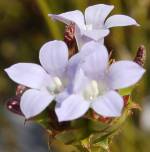
Roella amplexicaulis Wolley-Dod
Erect, rigid. Leaves crowded, imbricate, recurved, rotund-ovate, sharply serrate on the upper part, ciliate on the lower, apiculate. Bracts orbicular. Flowers white or pale blue, 3-8 in terminal heads. Flowering from November to April. Distribution and habitat: Endemic to the Cape Peninsula, on sandstone slopes.
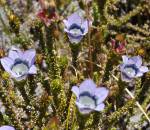
Roella ciliata L.
Erect or sprawling. Leaves linear, ciliate, axillary clusters of smaller leaves present. Flowers white or blue with a dark ring or spots on lobes, the dark part often edged with white, terminal, solitary, bell-shaped. Flowering from August to March. Distribution and habitat: Cape Peninsula to Caledon where it grows on stony slopes or sandy flats.

Roella prostrata E.Mey. ex A.DC.
Erect or sprawling. Leaves linear, ciliate, midrib prominent beneath, axillary clusters of smaller leaves present. Flowers white or pale blue, solitary at branch tips. Flowering from December to March. Distribution and habitat: Hopefield to Caledon, on sandy flats.
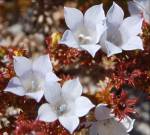
Roella recurvata A.DC.
Erect, branching from the base. Leaves crowded, imbricate, spreading or recurved, elliptic, apiculate, ciliate, slightly decurrent. Bracts leaf-like, recurved. Flowers white or blue, solitary at branch tips. Flowering from January to February. Distribution and habitat: Endemic to the Cape Peninsula, on sandy flats.
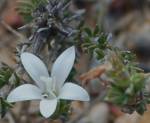
Roella spicata L.f.
Erect or diffuse. Leaves crowded, linear, axillary clusters of smaller glabrous leaves often present. Bracts leaf-like, broad at the base. Flowers white, in terminal or lateral heads aggregated into a spike-like inflorescence. Flowering from January to March. Distribution and habitat: Genadendal to Port Elizabeth where it occurs on rocky mountain slopes.
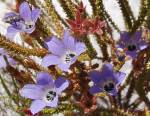
Roella triflora (R.D. Good) Adamson
Erect with ascending branches. Leaves linear, ciliate near the base, toothed on the upper part, axillary clusters of smaller leaves present. Bracts finely hairy, margins with stiff wire-like hairs. Flowers pale blue with a dark band at the base, solitary or in groups at branch tips. Flowering from December to April. Distribution and habitat: Endemic to the Cape Peninsula where is occurs on sandy lower slopes.

Roella uncinata Cupido
Perennial herb, tufted, up to 10 cm tall. Leaves linear, uncinate, scattered to densely imbricate, glabrous, margins ciliate, 1 or 2 pairs of teeth near apex; bracts leaf-like. Flowers 1 –4, terminal, white or pale blue. Flowering from November to February. Distribution and habitat : Endemic to Hermanus where it grows on sandstone slopes.
References
- Adamson, R.S. 1952. A revision of the genera Prismatocarpus and Roella. Journal of South African Botany 27: 93 - 166.
- Cupido, C.N. 2010. A new species of Roella (Campanulaceae) from Western Cape, South Africa. Edinburgh Journal of Botany 67: 425 - 430.
- Leistner, O.A. (ed.). 2000. Seeds plants of southern Africa: families and genera. Strelitzia 10. National Botanical Institute, Pretoria.
Credits
Christopher Cupido
Compton Herbarium, Kirstenbosch
March 2011
Plant Attributes:
Plant Type: Perennial, Shrub
SA Distribution:
Soil type:
Flowering season:
PH:
Flower colour:
Aspect:
Gardening skill:
Special Features:
Horticultural zones






Rate this article
Article well written and informative
Rate this plant
Is this an interesting plant?
Login to add your Comment
Back to topNot registered yet? Click here to register.